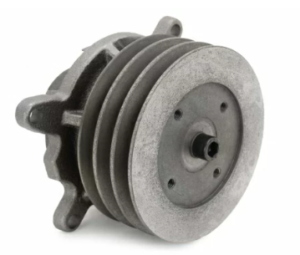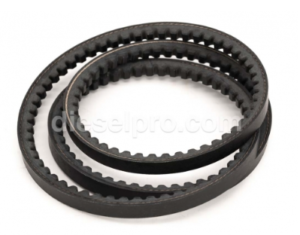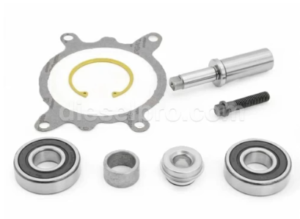
At this extended maintenance interval, the Caterpillar 3208 marine engine requires crucial attention to its cooling system, specifically adding the coolant extender (ELC) and conducting a thorough water pump inspection. These tasks help ensure optimal engine temperature regulation and prevent catastrophic failures, safeguarding both performance and longevity.
Adding Coolant Extender (ELC)
Understanding the Role of Coolant Extender
The Extended Life Coolant (ELC) is a specially formulated coolant that provides long-term protection against corrosion, cavitation, and scaling in the cooling system. Unlike traditional coolants that require frequent additions of Supplemental Coolant Additive (SCA), ELC offers superior protection and requires a coolant extender only at specific intervals, such as every 108,000 liters (28,500 US gallons), 3000 service hours, or 2 years.
Adding the coolant extender ensures the continued effectiveness of the ELC, extending the coolant’s life and maintaining its protective properties.
Step-by-Step Procedure to Add Coolant Extender
1. Safety Preparation
- Engine Cool-Down: Allow the engine to cool completely. Never open the cooling system while it is hot or pressurized.
- Personal Protective Equipment (PPE): Wear gloves, safety goggles, and protective clothing to prevent contact with coolant.
2. Locate the Coolant Filler Cap
- Identify the coolant reservoir or filler cap on the Caterpillar 3208 marine engine.
- Slowly loosen the filler cap to release any residual pressure.
3. Check Coolant Levels
- Observe the coolant level in the reservoir or expansion tank. It should be at or just below the “FULL” mark when cold.
4. Determine the Required Extender Volume
- Refer to the engine’s cooling system capacity (found in the Operation & Maintenance Manual).
- Calculate the required amount of coolant extender based on system capacity.
5. Add the Coolant Extender
- Pour the coolant extender directly into the coolant system.
- If necessary, drain a small volume of coolant to create space for the extender.
6. Mix Thoroughly
- Start the engine and run it at low idle for several minutes.
- Monitor coolant levels and top off as necessary.
7. Inspect for Leaks
- Check all hoses, clamps, and connections for leaks after adding the extender.
Best Practices for Coolant Extender Maintenance
- Use Only OEM-Approved Extender: To maintain warranty and ensure compatibility.
- Monitor Coolant Condition: Even with ELC and extender, check coolant clarity and chemical balance during regular servicing.
- Avoid Mixing Coolants: Mixing ELC with conventional coolants or different brands can compromise protection.
- Maintain a Service Log: Record the date, quantity of extender added, and engine hours.
Why Adding Coolant Extender Matters
- Maintains Corrosion Protection: Ensures coolant continues to protect metal components from rust and corrosion.
- Prevents Cavitation: Maintains the coolant’s ability to prevent pitting in cylinder liners.
- Extends Coolant Life: Reduces the frequency of full coolant changes, saving time and costs.
Inspecting the Water Pump

The Critical Role of the Water Pump
The water pump circulates coolant throughout the engine, ensuring optimal temperature control. A failing water pump can lead to overheating, resulting in severe engine damage such as cylinder head warping, gasket failure, and even complete engine seizure.
Regular inspection of the water pump at this interval is essential to identify wear, leaks, or mechanical issues.
Step-by-Step Water Pump Inspection
1. Safety Preparation
- Engine Off and Cooled: Ensure the engine is not running and has cooled fully.
- Disconnect the Battery: To prevent accidental engine starts.
2. Visual Inspection
- Check for Leaks: Look around the water pump housing, weep hole, and shaft seal for signs of coolant leakage.
- Inspect for Corrosion: Look for rust or scaling around the pump housing and connections.
- Examine the Pulley and Belt: Check for proper belt tension and pulley alignment.
3. Physical Check
- Wobble Test: Gently attempt to move the water pump pulley or shaft. Any play may indicate worn bearings.
- Noise Test: Rotate the pump by hand. A grinding or rough feeling may signal bearing wear.
4. Check Hoses and Connections
- Inspect Hoses: Ensure hoses connected to the water pump are free from cracks, bulges, and secure with tight clamps.
- Clamp Integrity: Replace loose or corroded clamps.
5. Pressure Test (Optional)
- If equipped, use a cooling system pressure tester to check for leaks around the pump under system pressure.
Replacing the Water Pump (If Necessary)

If the inspection reveals leaks, excessive wear, or mechanical failure:
- Drain Coolant: Remove enough coolant to prevent spills.
- Remove Drive Belt and Pulleys: If applicable.
- Unbolt and Remove Water Pump: Take care not to damage gaskets or mating surfaces.
- Clean Mounting Surface: Ensure old gasket material is removed.
- Install New Water Pump: Use OEM parts and torque bolts to specifications.
- Refill Coolant System: Top off with ELC and coolant extender as needed.
- Run Engine and Inspect: Check for leaks and proper operation.
Best Practices for Water Pump Maintenance

- Use OEM Parts: Ensures compatibility and reliability.
- Replace Gaskets and Seals: Always use new components to prevent leaks.
- Check Belt Tension: A new pump may require belt tension adjustments.
- Document Maintenance: Record service details for future reference.
Why Water Pump Inspection Matters
- Prevents Overheating: Ensures efficient coolant circulation.
- Avoids Catastrophic Failures: Early detection of wear can prevent major engine damage.
- Maintains Fuel Efficiency: A properly functioning cooling system supports optimal combustion.
- Protects Against Costly Repairs: Regular checks minimize the risk of unplanned downtime and expensive overhauls.
Comprehensive Summary for the 108,000 L / 3000-Hour / 2-Year Interval
Servicing the Caterpillar 3208 marine engine at this major milestone involves:
- Adding Coolant Extender (ELC): Extends the life of the coolant, maintaining corrosion and cavitation protection.
- Inspecting the Water Pump: Identifies leaks, wear, and mechanical issues to prevent overheating.
By following these detailed procedures and best practices:
- Engine reliability is maximized.
- Operating costs are reduced.
- The risk of sudden failures is minimized.
Safety and Compliance Reminder
- Follow Caterpillar’s Official Operation & Maintenance Manual: Always consult the manual for detailed specifications, torque values, and safety protocols.
- Use Personal Protective Equipment (PPE): Protect yourself from chemicals and mechanical hazards.
- Dispose of Fluids Responsibly: Adhere to environmental regulations for disposal of coolant and parts.
Additional Resources
Practical Guide To Servicing The Caterpillar 3208 Marine Engine
Marine CAT 3208 Component Maintenance Life
Caterpillar 3208 Injectors: High-Quality Aftermarket Options from Diesel Pro Power
The History of the Caterpillar 3208 Engine
Common Applications of the Caterpillar 3208 Engine
Troubleshooting Common Issues with the Caterpillar 3208
Maintenance Tips for Maximizing the Life of Your Caterpillar 3208 Engine



 Free US Calls: 1-888-433-4735
Free US Calls: 1-888-433-4735 International: 305-545-5588
International: 305-545-5588